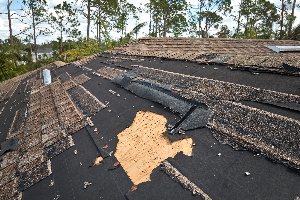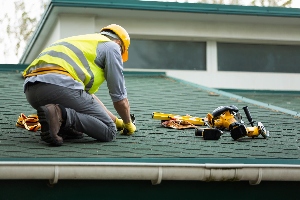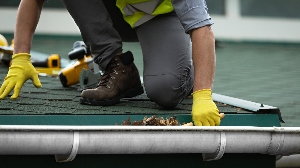Weather changes can seriously damage your home's foundation, leading to expensive repairs that many homeowners never see coming. Understanding how different weather conditions affect your foundation is essential for protecting one of your home's most important structural elements.
As temperatures shift and moisture levels change throughout the year, the soil around your foundation expands and contracts, creating pressure that can crack walls and cause structural problems.
Rain, drought, freezing temperatures, and extreme weather events all impact the stability of the ground beneath your house in different ways. Recognizing the warning signs early and taking simple steps to protect your foundation can save thousands of dollars in repairs.
In this article, you’ll learn how weather impacts home foundation and the practical steps to prevent cracking, settling, and moisture damage.
Here’s what you need to know:
- Why weather plays a major role in foundation health
- How specific weather conditions damage foundations
- Warning signs of weather-related foundation issues
- How to protect your home foundation year-round
Keep reading! Learning about seasonal threats, spotting damage before it gets worse, and knowing how to shield your foundation from weather will help keep your home safe and stable for years to come.
Why weather plays a major role in foundation health
Weather directly affects the soil around your home's foundation through temperature changes and moisture levels. Each season brings specific challenges that can damage foundations over time.
How temperature changes cause soil expansion and contraction
Soil naturally expands and contracts with temperature changes. When temperatures rise, soil particles heat up and expand outward. When temperatures drop, soil contracts and shrinks.
This constant movement puts stress on foundation walls. The soil pushes against the foundation when it expands. It pulls away when it contracts.
Clay soils are especially problematic during temperature swings. Clay can expand up to 15% of its original volume when wet and warm. It shrinks significantly when cold and dry.
Temperature-related foundation damage includes:
- Vertical cracks in foundation walls
- Horizontal displacement
- Uneven settling
- Gaps between foundation and soil
Winter freeze-thaw cycles create the most damage. Water in soil freezes and expands with tremendous force. This process can push foundation walls inward or cause them to bow.
The link between moisture levels and foundation settling
Water content in soil determines how much pressure it puts on foundations. Saturated soil becomes heavy and unstable. Dry soil shrinks and loses its support strength.
Heavy rains cause soil to absorb large amounts of water quickly. The extra weight pushes down on the foundation. Waterlogged soil also loses its ability to support the foundation properly.
Drought conditions create the opposite problem. Soil shrinks as moisture evaporates. This leaves gaps around the foundation where soil used to provide support.
Moisture-related foundation problems:
- Uneven settling as soil support changes
- Foundation sinking into soft, wet soil
- Cracks from loss of soil support during dry periods
- Basement wall bowing from hydrostatic pressure
The soil type around your home affects how moisture impacts the foundation. Sandy soils drain quickly but provide less support when wet. Clay soils hold water longer and create more pressure changes.
Why different seasons bring unique foundation challenges
Spring brings heavy rains and snowmelt that saturate soil around foundations. The rapid increase in soil moisture creates hydrostatic pressure against foundation walls.
Summer heat causes soil to dry out and shrink away from foundations. This removes crucial support and can cause foundations to settle unevenly. Hot weather also expands foundation materials themselves.
Fall weather brings temperature swings that cause repeated expansion and contraction cycles. These constant changes weaken foundation materials over time.
Winter creates the harshest conditions for foundations. Freezing temperatures cause:
- Ice formation that expands with tremendous force
- Frost heave that lifts foundations upward
- Frozen soil that cannot absorb water properly
Each season requires different protection strategies. Proper drainage helps during wet seasons. Consistent soil moisture prevents excessive shrinking during dry periods.
How specific weather conditions damage foundations
Different weather patterns create unique threats to foundation stability through soil changes, water damage, and temperature stress. Rain saturates soil and reduces its load-bearing capacity, while drought causes soil to shrink and crack beneath foundations.
How heavy rain and flooding weaken soil stability
Heavy rainfall transforms stable soil into a foundation threat. Water saturates the ground around homes, changing how soil behaves under pressure.
Saturated soil loses its ability to support weight effectively. The water fills spaces between soil particles, making the ground soft and unstable.
Immediate effects of heavy rain:
- Soil becomes waterlogged and weak
- Ground shifts and settles unevenly
- Foundation walls face increased water pressure
Flooding creates even worse conditions. Standing water around foundations increases hydrostatic pressure against basement walls.
This pressure can cause walls to bow inward or develop cracks. The longer water stays around a foundation, the more damage it causes.
Poor drainage makes rain damage worse. Water that cannot flow away from the house continues to weaken soil for days or weeks.
According to DOE’s Building America guidance, grading around the perimeter should maintain roughly a 5% slope—about a 6-inch drop within the first 10 feet—to direct stormwater away from the foundation and reduce hydrostatic pressure on basement walls.
Clay soils expand when wet, pushing against foundation walls. This expansion creates stress that can crack concrete and shift foundations.
The effects of drought and dry soil on foundation cracks
Dry weather causes soil to shrink away from foundations. This shrinking creates gaps where soil once provided support.
Clay soils shrink the most during drought conditions. As water leaves clay particles, the soil volume decreases significantly.
Problems caused by dry soil:
- Soil pulls away from foundation walls
- Uneven support leads to settling
- Cracks develop in foundation walls
- Foundation becomes unstable
The shrinking process happens slowly but causes serious damage. Foundations lose support gradually, creating stress points that lead to cracks.
Different soil types shrink at different rates. This uneven shrinking causes foundations to settle unevenly, creating structural problems.
Tree roots make drought damage worse. Large trees near foundations pull moisture from soil, increasing shrinkage around the house.
When rain returns after drought, soil expands again. This cycle of shrinking and expanding repeatedly stresses foundations.
How freeze-thaw cycles impact concrete strength over time
Temperature changes create powerful forces that damage concrete foundations. Water expands by 9% when it freezes, creating pressure inside concrete.
Small cracks in concrete fill with water during warm periods. When temperatures drop, this water freezes and expands.
The expanding ice pushes against crack walls, making them wider and deeper. Each freeze-thaw cycle makes existing cracks worse.
Freeze-thaw damage process:
- Water enters small cracks
- Temperatures drop below freezing
- Water expands as it becomes ice
- Cracks grow larger from pressure
- More water enters during thaw
This process repeats throughout winter months. Areas with frequent temperature swings around freezing point suffer the most damage.
Older concrete foundations face higher risks. Years of small cracks provide more entry points for water that will freeze.
Poor concrete quality makes freeze damage worse. Concrete with high water content or improper mixing cracks more easily when frozen.
Salt from de-icing can speed up this damage. Salt helps water penetrate deeper into concrete before freezing occurs.
Warning signs of weather-related foundation issues
Weather changes create visible signs of foundation damage that homeowners can spot early. These warning signs typically appear as structural shifts, movement problems, and drainage issues around the home.
Cracks in walls, floors, or brickwork after weather shifts
Foundation cracks often appear after extreme weather events like droughts, heavy rains, or freeze-thaw cycles. These cracks show up in different ways depending on the type of foundation damage.
Horizontal cracks in basement walls signal serious pressure from soil movement. They typically measure more than 1/8 inch wide and grow longer over time.
Vertical cracks in walls above the foundation indicate settling or shifting. These cracks often start small but widen after weather changes.
Stair-step cracks in brick or block walls follow the mortar joints. They create a zigzag pattern that shows uneven foundation movement.
Floor cracks appear as hairline fractures in concrete slabs. They become more noticeable after the ground expands or contracts from weather changes.
New cracks that appear within weeks of weather events need immediate attention. Old cracks that suddenly grow wider also signal active foundation problems.
Sticking doors and uneven floors caused by soil movement
Doors and windows that suddenly stick or won't close properly indicate foundation shifting. This happens when soil movement causes the house frame to become unlevel.
Doors may stick at the top, bottom, or sides of the frame. Windows might be hard to open or close smoothly. These problems often get worse after heavy rains or dry spells.
Floor symptoms include:
- Gaps between the floor and baseboards
- Sloping or sagging areas
- Creaking sounds when walking
- Furniture that rocks on flat surfaces
Soil movement affects different foundation types in various ways. Clay soil expands when wet and shrinks when dry. This creates the most dramatic foundation shifts.
Interior doors that worked fine before weather changes are strong indicators of foundation issues. The house frame follows foundation movement and creates these alignment problems.
Water pooling near the base of your home after storms
Standing water around the foundation creates serious long-term damage risks. This water puts pressure against foundation walls and can cause soil erosion.
Problem areas to check:
- Water that stays pooled for more than 24 hours after rain
- Soggy soil directly against foundation walls
- Puddles that form in the same spots repeatedly
- Water stains on foundation walls
Poor drainage allows water to saturate the soil around foundations. This extra moisture causes soil to expand and push against walls.
Gutters that overflow or point water toward the house create pooling problems. Grading that slopes toward the foundation instead of away also causes water issues.
Foundation cracks often leak when water pools outside. Homeowners may notice damp spots or actual water inside basements or crawl spaces.
How to protect your home foundation year-round
Protecting a foundation requires focused attention on proper water management, regular monitoring for damage signs, and professional intervention when problems arise. These three strategies work together to prevent costly structural issues and maintain home stability.
The importance of proper drainage and grading
According to the U.S. Department of Energy, new and existing homes should “install well-designed guttering and downspouts connected to a drainage system” and “slope the earth away from all sides of the house for at least 5 feet at a minimum 5% grade (about 3 inches in 5 feet)” to keep water from loading soils and pressing against foundation walls.
Poor drainage causes more foundation problems than any other factor. Water that pools around a home's base creates pressure that can crack concrete and shift soil.
Proper grading directs water away from the foundation. The ground should slope at least 6 inches over the first 10 feet from the house. This simple measurement prevents water from collecting near foundation walls.
Gutters and downspouts must stay clean and functional. Clogged gutters overflow and dump water directly onto the foundation. Downspouts should extend at least 4 feet from the house.
French drains help when natural grading isn't enough. These systems collect groundwater and channel it away from the foundation before it causes problems.
Drainage Solution
Purpose
Maintenance Needed
Proper grading
Direct surface water away
Check slope annually
Clean gutters
Prevent overflow
Clean twice yearly
Extended downspouts
Move water from foundation
Inspect after storms
French drains
Handle groundwater
Professional check every 3 years
Seasonal inspections to spot early signs of damage
Foundation problems start small but grow quickly if ignored. Regular seasonal foundation maintenance catches issues before they become expensive repairs.
Spring inspections focus on winter damage. Look for new cracks in basement walls or changes in existing ones. Check for water stains that show where moisture entered during snow melts.
Summer checks monitor drought effects. Soil shrinks when it dries out, which can cause foundations to settle unevenly. Watch for doors that stick or gaps around windows.
Fall preparation gets foundations ready for winter. Clear debris from drainage areas and seal small cracks before water can freeze inside them.
Key warning signs include:
- Cracks wider than a quarter-inch
- Doors or windows that won't close properly
- Uneven or sloping floors
- Water stains on basement walls
- Gaps between walls and ceilings
How professional foundation repair prevents long-term costs
Small foundation problems cost hundreds of dollars to fix. Major structural damage can cost tens of thousands.
Professional contractors have tools that homeowners don't. They use specialized equipment to measure foundation movement and identify problems that aren't visible on the surface.
Early moisture and foundation repair stops minor issues from spreading. A small crack sealed properly won't let water in to cause bigger problems later.
Professional assessment determines if problems are serious or cosmetic. Not every crack needs major repair, but only experts can tell the difference reliably.
Warranty protection comes with professional work. Most foundation repair companies guarantee their work for several years, which protects homeowners from future costs.
Regular professional inspections cost $200-400 but can prevent repairs that cost $10,000 or more. This investment pays for itself when it catches problems early.
Conclusion
Weather affects every home's foundation through soil movement and temperature changes. These natural forces can cause serious damage over time.
Homeowners can protect their foundations by maintaining proper drainage. This means keeping gutters clean and directing water away from the house.
Regular inspections help catch problems early. Look for cracks, settling, or moisture issues around the foundation.
The cost of prevention is much lower than major foundation repairs. Small fixes now prevent big problems later.
Weather damage to foundations happens slowly but steadily. Homeowners who take action early save money and avoid structural issues.
Professional inspections can identify problems that homeowners might miss. Foundation experts know what warning signs to look for.
Climate change means more extreme weather events. This makes foundation protection more important than ever.
Smart homeowners prepare their foundations for all weather conditions. They understand that their foundation supports their entire home investment.
Schedule a foundation inspection with Michaelis today to diagnose weather-related movement, fix drainage issues, and protect your home’s structure.




.avif)

